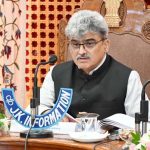In the wake of the tragic Pahalgam terrorist attack, India demonstrated a near-perfect representation of strategic diplomacy, anti-terrorist coherence, and global engagement. The state machinery refrained from acting out of reflexive aggression or preceding emotional rhetoric and chose instead to pursue measured diplomacy with multiple stakeholders, wherein moral vigor was allied with factual accuracy. Such high-mindedness and virtue bespeak the maturity of a dignified Republic that sees cooperation, rather than isolation, as being the most powerful force multiplier against terrorism.
The most notable post-event reactions of India is the swift activation of parliamentary diplomacy. Dispatching seven multi-party delegations to 33 nations was a statement of intention and a reflection of the Indian style of inclusive foreign policy. This broke any opposition attempt at portraying the nation as divided. Such seldom-seen unity in foreign matters placed before the world the fact that in matters of national security, India speaks with one voice.
With this initiative, India ensured that the Pahalgam attack would not be treated as a mere internal matter of India but as a serious turning point in the international fight against cross-border terrorism. India completely recast the discourse away from the narrow prism of Kashmir to encompass international law, human rights, and religious sanctity.
What made the Indian approach different was that it stood for the moral high ground without showing any apparent weakness. In choosing to go the diplomatic route rather than retaliate at once, the Indian government pre-empted any appearances of weakness, thus its strength. It was the mark of a Regional Power with responsibility. This was not passivity but aiming in the long term to isolate the menace of terrorism diplomatically, economically, and morally in global affairs.
India’s emphasis on involving Islamic countries like Iran, Saudi Arabia, Egypt, and Bahrain was especially shrewd. This sensitive positioning enabled the government to state unequivocally that Islam and terror could be differentiated, a message that struck a deep chord in the Muslim world and yielded India precious diplomatic capital in the Gulf and elsewhere.
As significant was the Indian government’s move to reach out to the Taliban regime in Afghanistan. Ideologically far apart, Taliban’s public denunciation of the attack, reportedly as a reaction to India’s overtures, was a moment of pragmatism. This overture served to strengthen the perception that India can approach all parties in the neighborhood when national interest requires it, without letting its values or principles come in the way.
India’s Foreign Service, usually underreported in the popular narrative, should be especially complimented on doing its painstaking spadework. The nicety with which facts, victim statements, and strategic briefs were put before capitals as diverse as Tokyo and Berlin, Nairobi and Buenos Aires, says much of institutional synergy. It was not just a demonstration of anguish but an extension of intent.
One of the most significant components of this initiative was the dispatch of seven all-party parliamentary delegations to 25 nations across the world. These delegations were carefully composed to reflect the inclusiveness of Indian democracy, with MPs from various political parties representing the country in key global capitals.
Congress MP Shashi Tharoor led the delegation to the United States, emphasizing that their mission was not partisan but national—built on the consensus that terrorism is a shared global threat. Kanimozhi Karunanidhi of the DMK spearheaded the delegation to Russia, where discussions revolved around strengthening counter-terrorism cooperation. KC Venugopal, also of the Congress, was part of the Public Accounts Committee already stationed in Kashmir at the time of the attack and provided immediate oversight on local developments.
The outreach also included a five-member Trinamool Congress delegation comprising Derek O’Brien, Md Nadimul Haque, Sagarika Ghose, Mamata Thakur, and senior minister Manas Bhuniya, who visited conflict-hit zones in Jammu & Kashmir to gather firsthand insights. This multi-party presence reinforced the perception of political maturity and bipartisan unity in India’s foreign policy response.
These dignitaries not only articulated India’s strategic concerns but humanized the national sentiment, lending a moral and democratic weight to the campaign. Their active participation in international forums helped shift the global perception of the Pahalgam attack from a regional skirmish to a pressing concern within the broader global fight against terrorism.
AIMIM MP Asaduddin Owaisi was also part of the all-party delegation that visited Bahrain. During the visit, Owaisi emphasized national unity by setting aside political differences to affirm India’s sovereignty and integrity. He condemned Pakistan, labeling it a “failed state,” and highlighted that the threat India has been facing for years emanates from Pakistan.
Owaisi called on Pakistan to end justifications for terrorism, dismantle terror networks, and take responsibility for cross-border terrorism. His participation underscored the unified front among Indian political representatives abroad, underlining the importance of national solidarity in international forums.
The coordinated all-party parliamentary delegations under Operation Sindoor sent a strong and unified diplomatic signal to the international community, reshaping the global narrative around the Pahalgam terrorist attack. By involving leaders across the political spectrum—including the Congress, DMK, TMC, AIMIM, and others—India effectively demonstrated that its stance against terrorism transcends domestic politics. This bipartisan unity added significant credibility to India’s appeals abroad, especially in countries where public opinion and policy are influenced by perceptions of internal political consensus.
When voices like Shashi Tharoor, Kanimozhi, and Asaduddin Owaisi stood shoulder to shoulder to call out Pakistan’s role in harboring terrorism, it made it difficult for any nation to dismiss India’s claims as politically motivated. The presence of opposition leaders added moral and democratic weight to India’s case, making it resonate more powerfully with foreign governments, media, and civil society organizations.
These delegations also disrupted Pakistan’s long-standing tactic of portraying the Kashmir issue as a matter of local unrest or human rights violations. The Indian MPs not only highlighted the external nature of the terrorist threat but also emphasized the broader global risks posed by Pakistan-sponsored extremism. This shifted the framing of the issue from a bilateral or regional conflict to a matter of international concern.
Moreover, the outreach helped India build stronger counter-terror alliances and gain support for its position in multilateral forums like the UN and the FATF. Countries that were earlier neutral or hesitant began acknowledging the legitimacy of India’s concerns, leading to diplomatic pressure on Pakistan to act against terrorist groups operating from its soil. The overall outcome was a clear diplomatic win for India, achieved not just through government channels but through democratic, inclusive, and strategic diplomacy.
For decades, India had often waited for the global community to acknowledge its concerns on cross-border terrorism. This time, India took the narrative abroad—crafting it, owning it, and steering it toward actionable outcomes. This narrative leadership, especially in multilateral fora, is a sign of India’s emergence as a normative power.
A defining success of India’s campaign was the manner in which it drew a clear line between democratic pluralism and terror-driven autocracy. In meetings with lawmakers in Europe and North America, Indian MPs underscored the challenges faced by the world’s largest democracy in upholding human rights amid existential security threats.
This juxtaposition highlighted India’s civilizational values and its commitment to preserving them despite provocations. India’s emphasis on international legal norms—particularly UN resolutions against terror financing and human rights conventions—was both timely and intelligent. It reminded the world that India’s position was grounded not just in national sentiment, but in international law. This legal framing resonated well in Western capitals where policymaking is increasingly driven by rules-based considerations.
The outreach also offered India an opportunity to question the global double standards on terrorism. For far too long, certain powers have maintained ambiguous postures on terror emanating from Pakistan. By presenting a structured narrative backed by evidence, India subtly challenged the selective morality of the global system. It asked a pressing question: can terrorism be condemned in one geography and tolerated in another?
India’s campaign also drew strength from its diaspora. Indian-origin parliamentarians, business leaders, and academics in countries like the US, UK, Canada, and Australia amplified New Delhi’s message through local media and public forums. This networked diplomacy added both cultural legitimacy and political reach to the government’s efforts, demonstrating the soft power depth of the Indian state.
Importantly, India resisted the temptation to securitize its domestic spaces in reaction to the attack. There were no sweeping arrests, no media trials, and no communal finger-pointing. This measured internal conduct, in stark contrast to global examples of state overreach post-terror incidents, enhanced India’s democratic credentials and made its external messaging even more credible.
It would be remiss not to note the role of Prime Minister Modi’s leadership in navigating the post-Pahalgam terrain. His decision to let institutional mechanisms, rather than political speeches, shape the response showed a rare blend of restraint and resolve. This decentralization of narrative control allowed India’s message to come through as more inclusive, less partisan, and therefore more persuasive globally.
India’s response has potentially reshaped the global discourse on Kashmir-related terrorism. No longer can it be dismissed as a bilateral or regional dispute. The Pahalgam attack, and India’s strategic internationalization of its consequences, forces the world to reckon with the broader implications of inaction in the face of state-sponsored radicalism.
The coordinated participation of Indian think tanks and research institutions in the diplomatic campaign added intellectual gravitas. Policy papers, briefings, and analytical reports complemented the emotional and moral dimensions of India’s message. This coupling of intellect and emotion gave India a multi-layered diplomatic arsenal.
India’s ability to speak in the language of the world—democracy, law, development, human rights—was vital to the success of its campaign. No longer is Indian diplomacy reactive or moralistic alone. It is now outcome-oriented, narrative-savvy, and evidence-driven—traits that are essential for global leadership in the 21st century.
In regions like Africa and Latin America, Indian MPs found unexpected support. Many leaders in these regions see India as a kindred spirit—a post-colonial democracy balancing growth, diversity, and security.
The most enduring impact of India’s campaign is the normalization of parliamentary diplomacy. By allowing elected MPs to carry the flag of foreign policy, the government democratized international engagement. This model has the potential to outlast the current administration and evolve into a foundational pillar of Indian diplomacy.
Lastly, India’s response to the Pahalgam attack has set a template for future crises. It reflects a matured nation-state that neither bends under threat nor explodes in fury. It dialogues, it documents, and it drives consensus. In the battle between the pen and the gun, India once again chose the former—and won global respect.
(Author is Professor of Comparative Literature and Chairman, Centre for Narendra Modi Studies (CNMS) www.namostudies.com. Email: [email protected])










